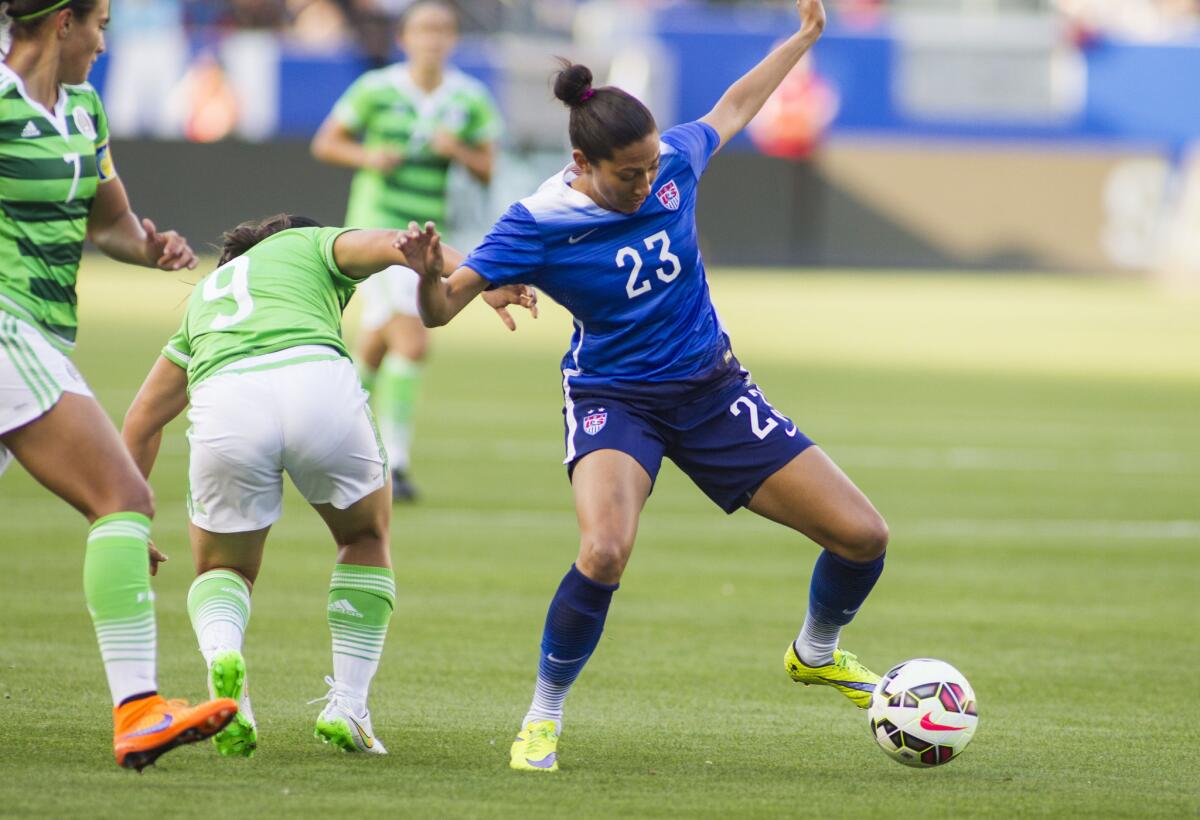California a women’s soccer stronghold — just look at World Cup teams

United States forward Christen Press is one of several national team players from the state of California.
- Share via
Reporting from San Jose — When forward Christen Press trotted onto the field for her first training session with the U.S. women’s national soccer team three years ago, introductions weren’t necessary.
Many of her teammates were people she had known for years.
Growing up in the South Bay, she began playing alongside future U.S. defender Whitney Engen when she was 8. As a teenager, Press competed against current U.S. forwards Alex Morgan and Amy Rodriguez, and national team midfielder Shannon Boxx, 11 years her senior, once coached Press.
“We were all there, all around each other, competing, fighting, pushing each other,” Press said. “And now, looking back, having the opportunity to play around other very motivated, competitive players pulls you along.”
Nowhere is that pull greater than in California, home to more than 250,000 registered girl soccer players and birthplace of six women on the U.S. team.
The state’s player pool is so deep, in fact, Californians will play for several World Cup teams.
Mexico also has nine players from the state on its national team while England has a goalkeeper, Karen Bardsley, who was born in Santa Monica and played at Cal State Fullerton. Defender Ali Riley went to Harvard-Westlake High in North Hollywood before joining the New Zealand national team, where she played with Simone Carmichael, a teammate of Boxx at South Torrance High. And Swiss defender Noelle Maritz grew up playing soccer — and baseball — in Newport Beach.
“There’s great players from everywhere,” said Tony DiCicco, who coached a U.S. team that included eight Californians to a World Cup title in 1999. “But California’s always developed a lot.”
The credit for that often goes to the state’s size and population as well as a climate that allows the sport to be played year-round. But DiCicco, a Connecticut native who runs an elite soccer academy, says there’s more to it than that.
“If you look at our girls playing the game in America, it’s a pretty narrow demographic. And then when you look at the nationality, there’s not a lot of outside influence like Latino or European or South American. It’s pretty much American kids playing the game,” he said.
“But in California, they do get that outside influence. They’re a little bit more technical. There’s a lot of players playing.”
Veronica Perez, who will be competing in her second World Cup for Mexico next month, agrees. She was on two club teams in the San Francisco Bay area and remembers playing a sophisticated style of soccer even as a young girl.
“We have a little more flair,” said Perez, 26.
The state’s solid and well-organized club culture has also been a factor in developing talent. Boxx spent six years with Torrance United, in addition to playing for her high school team, while Rodriguez won two age-group national club team titles with the Laguna Hills Eclipse and Morgan played for Cypress Elite.
And all three played in the American Youth Soccer Organization before that.
For Press, who played AYSO then graduated to the Slammers FC of Newport Beach club team, there was always a feeling that if you could make it in California, you could make it anywhere.
“Growing up, we used to think if we could win state cup and come out of Southern California, we would win the national [club] championship,” said Press, who made it to the national title game four times in six years, winning twice.
That success allowed Press to measure herself against the best age-group players in the country, many of whom she played against on a regular basis in California. So when others were chosen for youth national teams or the Olympic Development Program while she was left behind, she drove herself even harder.
“The youth development national teams and ODP plays into it,” said Press, 26, who was invited to her first national team camp four years ago. “A lot of the girls get that training from being identified at a really, really young age. I remember looking at all the girls in the national team thinking ‘I can play with them. Why aren’t I there? And what do I need to do to get there?’”
Given the depth of talent, national team coaches aren’t the only ones scouting California. College recruiters have also flocked to the state, which produced a quarter of the players on last season’s women’s All-America team. And in 2013 UCLA Coach Amanda Cromwell won a national championship with a roster that featured 20 Californians.
“The kids are just at such a high level because there’s so much competition out here,” said Cromwell, a former U.S. national team defender from Virginia who coached at Central Florida and Maryland Baltimore County before coming to UCLA two years ago. “They get to train year-round. There’s a lot of commitment to the youth system. Every girl in California just seems to play soccer.
“They get good coaching. And they play against some of the best players in the country on a weekly basis. Girls in other states, they don’t have the same competition.”
Rodriguez, 28, agrees, saying California’s soccer accomplishments are the result of several factors working together. “We’re always in great weather. There’s a lot of club teams. There were so many great players in the area that really just made me get better,” she said.
“When I go back and look at the girls, they are way better than I was at that age. Development. Skill set. Training. We’ve gotten so much smarter.”
Twitter: @kbaxter11
More to Read
Go beyond the scoreboard
Get the latest on L.A.'s teams in the daily Sports Report newsletter.
You may occasionally receive promotional content from the Los Angeles Times.







